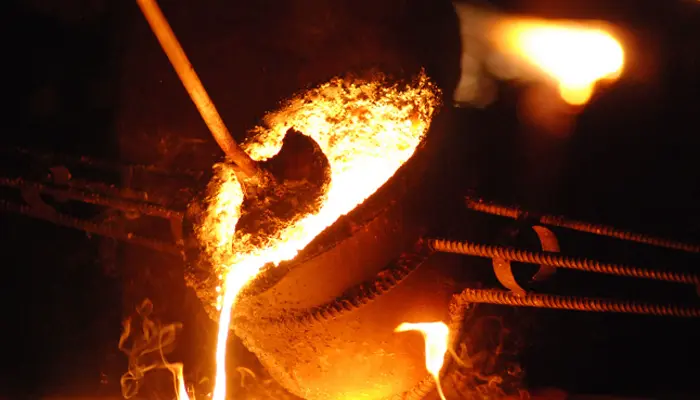Gray cast iron smelting and pouring defects cause analysis and solutions
(1) Porosity during gray cast iron smelting and pouring
Characteristics and detection methods:
Sieve-like pores: relatively evenly distributed on the entire or most of the cross-section of the casting.
Subcutaneous pores: densely distributed fine pores appear 1 to 3 mm from the surface of the casting.
Can be found by appearance inspection, mechanical processing, shot blasting or magnetic particle inspection.
Cause analysis:
When the gas content in the molten iron is high and the pouring temperature is too low, the precipitated gas does not have time to float up and overflow the casting.
1. The charge itself has a high gas content, or is severely rusted, and there is a lot of grease on the surface.
2. Subcutaneous pinholes are mainly caused by hydrogen. Silicon can reduce the oxygen content in cast iron, but can increase the hydrogen content, so high-silicon cast iron is prone to hydrogen pores. Pinholes are also prone to occur when the charge contains aluminum or alumina.
3. The molten iron bag is not dry.
4. The inoculant is not dry.
Prevention methods:
1. The charge should be properly managed. Charges with severe rust or excessive surface grease should be cleaned or treated before use.
2. Charges with high gas content should be remelted before use.
3. An appropriate amount of rare earth can be added in front of the furnace to degas.
4. Control the appropriate temperature of the molten iron out of the furnace and the pouring temperature.
5. The molten iron ladle needs to be dried.
6. Avoid interruption during pouring.
7. The inoculant should be fully preheated.
8. During pouring, ignition and air entrainment must be performed.
(2) Unqualified composition, structure and performance
Characteristics and discovery methods:
The material is too hard or too soft.
The macrostructure and microstructure of the casting section do not meet the standards or technical conditions.
It can be found by cross-section observation, chemical analysis, metallographic examination, hardness test, etc.
Cause analysis of gray cast iron smelting:
1. When the carbon-silicon equivalent is low, the material is hard, and when the carbon-silicon equivalent is high, it is soft.
2. Improper overheating of molten iron.
3. Inadequate inoculation treatment.
Prevention methods:
1. Correctly mix materials and prevent material leakage during operation.
2. Control the appropriate overheating temperature.
3. Comply with operating procedures and correctly handle pre-furnace inoculation.
(3) Shrinkage
Characteristics and discovery methods:
There are many scattered small shrinkage cavities inside the casting, and its surface is rough, which leaks water during the water pressure test.
It can be found by mechanical processing or magnetic particle inspection.
Cause analysis:
When the phosphorus content is high, the solidification range is expanded; at the same time, the low-melting-point phosphorus eutectic cannot be supplemented during the final solidification, resulting in micro shrinkage cavities. Especially for high-grade cast iron (low carbon content), the volume shrinkage is large, so more attention should be paid. The pouring speed is too fast, and the parts that need to be compensated for shrinkage cannot be replenished with enough molten iron in time.
Prevention methods:
1. Generally control phosphorus below 0.15%, and control the chemical composition of molten iron to be stable.
2. When pouring, pour slowly to facilitate sufficient shrinkage compensation.
(4) Shrinkage holes
Characteristics and detection methods: Concentrated holes with irregular shapes and rough surfaces are generated in the hot spots of the casting.
It can be found by appearance inspection, machining or magnetic particle inspection.
Cause analysis:
1. Due to the large volume shrinkage, the chemical composition of the molten iron does not meet the technical requirements, especially for high-grade low-carbon cast iron.
2. The pouring temperature is too high, which increases the liquid shrinkage value.
Prevention methods:
1. Correctly control the chemical composition of the molten iron. Try to keep the sulfur as low as possible, generally below 0.12%.
2. Control the appropriate pouring temperature.
3. For large parts, additional molten iron can be poured at the riser.
4. Appropriately increase the inoculation amount.
(5) Hot cracking
Characteristics and detection methods:
The crack has a dark or almost black oxidized surface.
Detected by appearance inspection, light transmission method, magnetic particle inspection, pressure test, kerosene penetration and other methods.
Cause analysis:
1. The chemical composition of the molten iron does not meet the requirements, resulting in a large solid shrinkage value, such as low carbon and high sulfur.
2. The casting contains low-melting-point slag inclusions, which reduces the high-temperature strength (because hot cracking occurs near the end of solidification, mainly caused by mechanical hindrance of shrinkage at the hot section of the casting).
Prevention methods:
1. Control the reasonable chemical composition and try to keep the sulfur content in the original molten iron as low as possible.
2. When pouring, avoid slag entering the mold cavity.
(6) Cold cracks
Characteristics and detection methods:
The cracks are relatively clean or slightly dark red with a slightly oxidized surface.
The detection method is the same as hot cracks.
Cause analysis:
1. The chemical composition of the molten iron does not meet the requirements, resulting in a large solid shrinkage value
2. The phosphorus content in the molten iron is too high, which increases the brittleness and thus reduces the tensile strength of the cast iron (because cold cracks occur after the casting is cooled, mainly at the stress concentration point at the junction of the thick and thin parts of the casting, due to thermal stress).
Prevention methods:
1. Control the reasonable chemical composition.
2. Generally, the phosphorus content in the molten iron should be below 0.15%.
(7) Slag eyes
Characteristics and detection methods:
There is slag in the holes outside or inside the casting
It can be found by appearance inspection, mechanical processing or magnetic particle inspection
Cause analysis:
1. There is too much slag in the molten iron or the slag in the molten iron ladle is not removed, and no attention is paid to slag blocking during pouring.
2. Slag brought in due to flow interruption during pouring.
Prevention methods:
1. Appropriately increase the temperature of the molten iron and add a small amount of dry sand to the molten iron ladle to facilitate the removal of slag. To prevent sulfur from re-transferring into the molten iron
2. Pre-remove the residue in the molten iron ladle.
3. Pay attention to slag blocking during pouring to prevent flow interruption.
(8) Iron beans
Characteristics and detection methods:
There are small iron beads in the pores.
It can be found by checking the cross section of the casting and machining.
Cause analysis:
Because the pouring temperature of the molten iron is too low, the iron beans produced when the molten iron splashes can no longer be melted by the molten iron, and are thus enclosed in the casting together with the external gas;
Prevention methods:
1. Appropriate pouring temperature.
2. Do not interrupt the flow during pouring.
(9) Cold shut and insufficient pouring
Characteristics and detection methods:
There are incompletely fused gaps or local lack of meat on the casting, with round edges around.
It can be found by visual inspection.
Cause analysis:
1. The temperature of the molten iron is too low, which reduces the fluidity of the molten iron.
2. When the carbon and silicon content in the molten iron is low and the sulfur content is high, the fluidity of the molten iron is also reduced.
3. When pouring, the flow is interrupted or the amount of molten iron is insufficient. When the secondary pouring is carried out, cold shut is easy to occur.
Prevention method of gray cast iron smelting:
1. Appropriately increase the pouring temperature of the molten iron.
2. Control the appropriate chemical composition of the molten iron and try to reduce the sulfur content.
3. Pour it all at once and avoid pouring. And the flow should not be interrupted during pouring.
(10) Overhardening
Characteristics and discovery methods:
White cast iron structure appears at the edge and thin wall of the casting.
It can be found by cross-section observation, hardness test, and mechanical processing.
Cause analysis:
1. The carbon-silicon equivalent is low.
2. Insufficient inoculation treatment.
Prevention method:
1. Correct ingredients.
2. Appropriately increase the inoculation amount.





